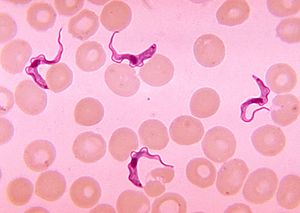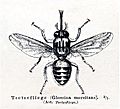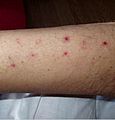Sleeping sickness facts for kids
Sleeping sickness, also called African trypanosomiasis, is a serious infectious disease. It is caused by tiny parasites called Trypanosoma brucei.
People get sleeping sickness from the bite of an infected tsetse fly. Because of this, the disease is mostly found in parts of Africa, especially Sub-Saharan Africa, where these flies live. Experts say that about 70 million people in 36 countries are at high risk of getting sleeping sickness.
In 2013, around 30,000 people had African trypanosomiasis. About 7,000 new cases were reported each year. Most of these cases (over 80%) were in the Democratic Republic of the Congo.
Good news! There are medicines that can treat African trypanosomiasis.
Contents
What Causes Sleeping Sickness?
Sleeping sickness is caused by very small living things called parasites. These parasites are a type of Trypanosoma brucei. They are so tiny you can only see them with a microscope!
How People Get Sick
The main way people get sleeping sickness is through the bite of a tsetse fly. When an infected tsetse fly bites a person, it passes the parasites into their body. This is why the disease is common only in areas where these flies live.
Where Sleeping Sickness Is Found
Sleeping sickness is found in certain parts of Africa. It is most common in Sub-Saharan Africa. This is because the tsetse fly, which carries the disease, lives in these regions. Many people in these areas are at risk of getting sick.
Treating the Disease
If someone gets sleeping sickness, they can be treated with special medicines. Finding and treating people early is very important to help them get better.
Images for kids
-
Two areas from a blood smear from a person with African trypanosomiasis, thin blood smear stained with Giemsa: Typical trypomastigote stages (the only stages found in people), with a posterior kinetoplast, a centrally located nucleus, an undulating membrane, and an anterior flagellum. The two Trypanosoma brucei subspecies that cause human trypanosomiasis, T. b. gambiense and T. b. rhodesiense, are indistinguishable morphologically. The trypanosomes' length range is 14 to 33 µm, Source: CDC
-
In 1903, David Bruce recognized the tsetse fly as the arthropod vector.
-
Numerous spots of bleeding into the skin of the leg in a person infected with T. b. rhodesiense
See also
 In Spanish: Tripanosomiasis africana para niños
In Spanish: Tripanosomiasis africana para niños







